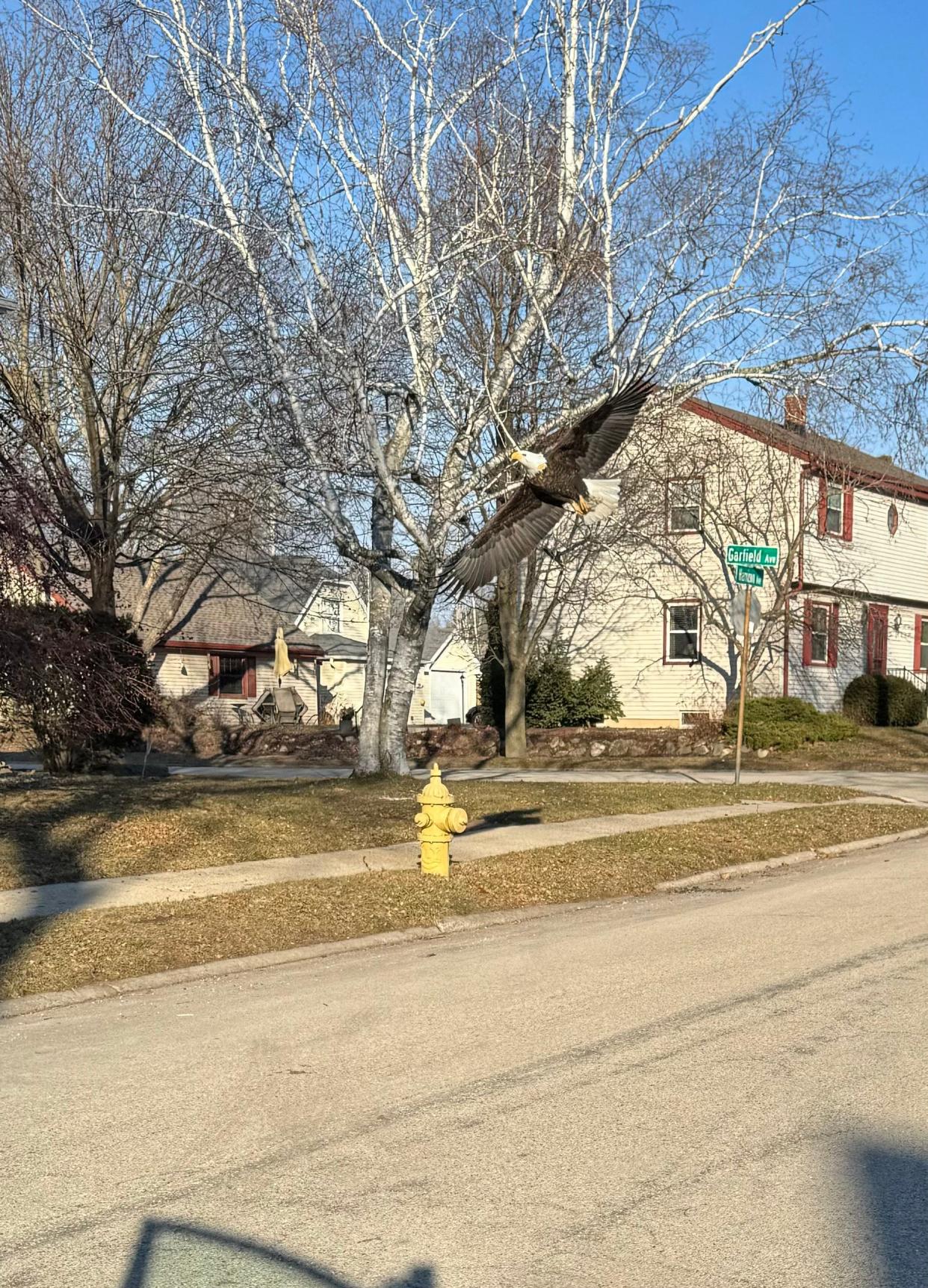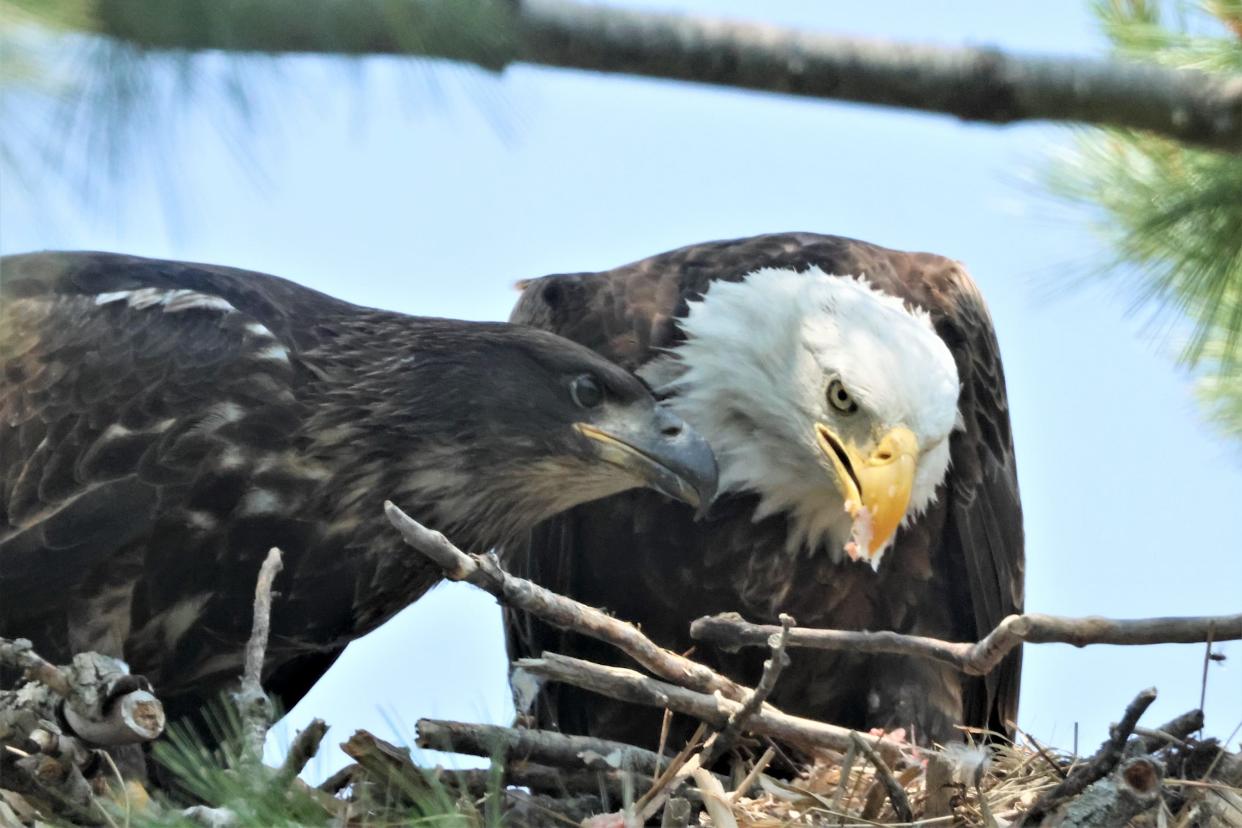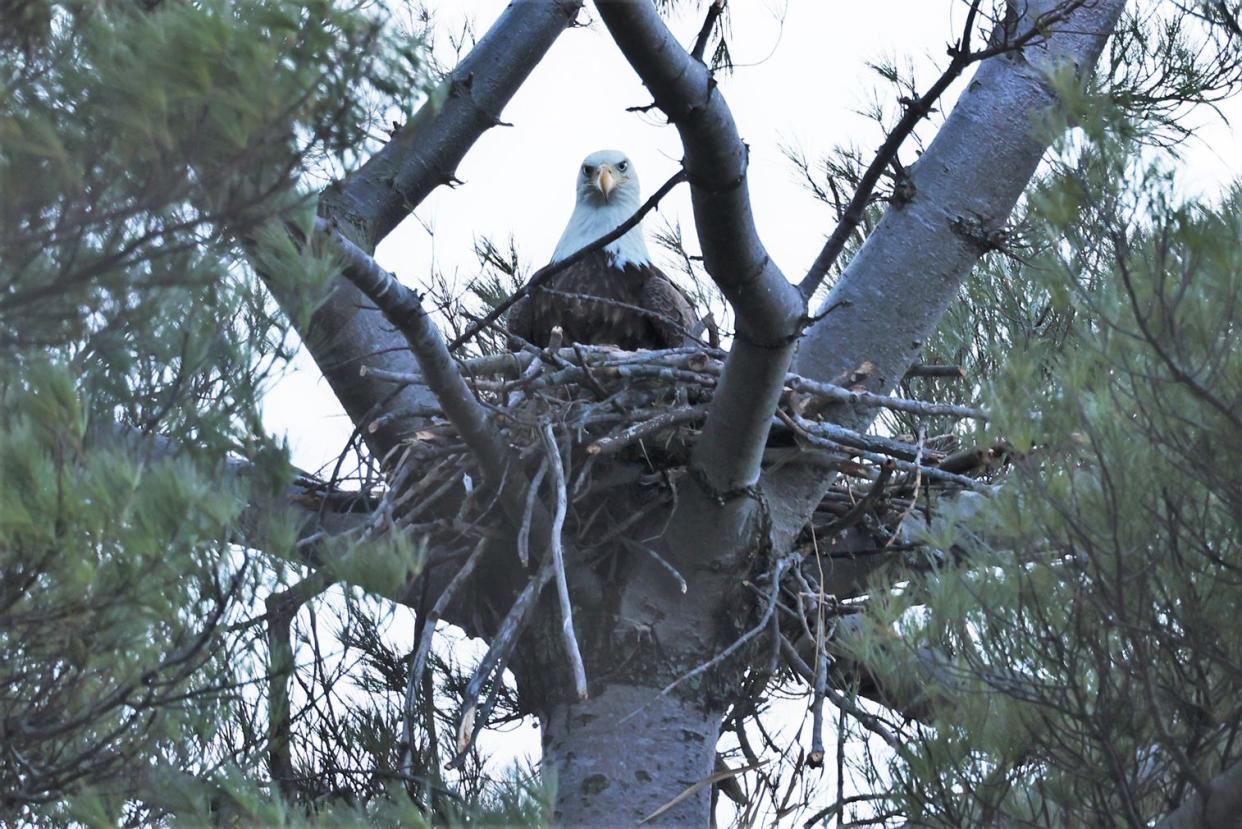Bald eagles in Waukesha? No doubt about it. But how and why? Those are the questions.

WAUKESHA - From a distance, what appear to be two hawks swoop above the trees, a common sight eliciting little reason for particular attention — that is, until you spot a glint of white shimmering in the afternoon sun.
It's that white-feathered pate that earned these birds of prey their name: bald eagles. And on this particular mid-February day, one in a flying pair leaves no doubt about its identity as it briefly scrapes its talons across the pavement of Harrison Avenue before resuming its flight in the middle of the city of Waukesha.
The sight is enough to stop two passing vehicles in their tracks, a reaction which isn't surprising given that decades ago such an occurrence would have been unheard of. Even today, on most urban streets, the only bald eagles typically found are metal castings at the end of flagpoles.
But that's changing, say naturalists who are aware of the increased sightings of the bird that serves as a national symbol.
"I have heard the public expressing joy and pride at the recovery of bald eagles in the state, especially now with eagles nesting in all 72 counties and the population growing to nearly 1,700 pairs," said Sumner Matteson, an avian ecologist with the Wisconsin Department of Natural Resources' Bureau of Natural Heritage Conservation. "It has been an outstanding partnership between federal, state, county, and local governments and the private sector in bringing eagles back from dire straits 50-60 years ago."
Bald eagles find a path back throughout Wisconsin
Such professionals have seen the progress in recent years, with gratitude.
On a dedicated web page titled "Eagles in Wisconsin," the DNR includes two maps comparing occupied bald eagle nests in 1974 and 2019. From a scattering along only the northern edge of the state 50 years ago to identified nests statewide, with high concentrations in northcentral Wisconsin five years ago, the map provides one kind of visual evidence of the dramatic charge.
The state DNR, and other agencies across the country, point to the successful conservation program enacted at that critical point. A national ban on the pesticide DDT, a major cause of the eagles' decline, in combination with protections built into federal and state endangered species laws are largely responsible, DNR officials say.
Other factors include river cleanup efforts, donations from the public, and an effort to monitor bald eagles by DNR’s Natural Heritage Conservation staff and partners.
Jeb Barzen, president of Ferry Bluff Eagle Council and Private Lands Conservation LLC, said statistically, the recovery of bald eagles becomes increasingly evident as time passes, moving further from the point when naturalists envisioned their extinction. He agrees that the elimination of DDT and derivatives under federal Environmental Protection Agency rules beginning in 1972 is the central reason for the rebound.
"The bald eagle population has increased dramatically since the 1970s when the Wisconsin population reached its nadir," Barzen said in an email interview. "In 1973 DNR surveys of occupied bald eagle territories during summer in Wisconsin totaled 108. In 2019, the last year of the DNR surveys, the total number of occupied bald eagle territories was estimated at 1,684 territories."

Sightings of bald eagles generate excitement in urban areas
Of course, such dramatic statistical changes, as evident in nesting maps or population figures, aren't as exciting as actually seeing a bald eagle flying overhead, close enough to see the raptor's iconic features — let alone, seeing one touchdown on a public street in central Waukesha and similar places.
Sightings in Wisconsin, even in urban areas such as Waukesha's century-old grid blocks, are "not as unusual as it would have been 20, or even 10 years ago," Barzen said. "Such a sighting is still a lucky circumstance but it is far more likely for that luck to be expressed now than it was in 1973."
One reason urban sightings are increasing is because the bald eagles have established new, or perhaps more accurately, renewed, territory where people are prevalent, he suggested.
"Some eagles are now nesting in relatively urban areas. In other areas, bald eagles will occur relatively close to people during winter when food, cover and human behavior allow eagles to gather successfully," Barzen said.
Since there really aren't many new nesting habitats in Wisconsin for bald eagles, the birds have adopted areas they would have found less desirable before. That includes places like the suburbs of Milwaukee.
"From the bald eagle point of view, this means that bald eagles have nested, or will winter, in places that are relatively close to human habitation," Barzen said. "Sensitivity to human disturbance, in other words, can decrease as bald eagle densities increase."

Ecologists remind people to keep bald eagles safe and sound
Despite the increasing visual interaction between bald eagles and people, naturalists and ecologists still voice the need for caution to ensure the eagle remains safe. Certainly, people should keep their distance, Barzen stressed. "Give the bird room. Don’t try to approach it or capture it," he said.
Hunters can help as well, according to DNR officials.
"My only advice would be to echo the words of Wisconsin’s leading eagle rehabilitator, Marge Gibson from the Raptor Education Group, Inc. in Antigo: Use copper bullets instead of lead when hunting because lead poisoning of eagles feeding on deer carcasses is a serious concern," Matteson said.
But there are firm rules to consider as well when bald eagles' nesting sites are involved. In a 2022 article about the discovery of a nest in Milwaukee County, Milwaukee Journal Sentinel outdoors editor Paul A. Smith included rules and laws cited by officials who continue to support bald eagle population recovery.
They note that bald eagles are extremely sensitive to disturbance during the nesting season (February through June) as they raise their young. And, they note, it's not just a matter of etiquette, nor a gentle caution, when it comes to harassing nesting eagles. Rather, the force of law is behind it.
According to federal law and the Bald and Golden Eagle Protection Act:
Anyone observing, photographing, or present near a bald eagle nest must remain 300 feet or more away from the nest to prevent disturbance and avoid causing the eagles to abandon their nest.
Use of drones at nest sites are strictly prohibited, as they are considered extremely disruptive to the nesting pair.
Observers should avoid agitating or flushing the eagles from the nest as well as minimize the use of flash photography. All of these precautions foster a safe environment for the eagles and eagle lovers.
Barzen said he can only guess why a bald eagle would swoop down to the street level in a place like Waukesha, given the effort it takes for the birds to climb in tight spaces. But as "an excellent soaring bird," it might still find a way to navigate such a "human canyon," catching the eye of the surprised individual who hardly expected to see a bald eagle up close in the city.
Contact reporter Jim Riccioli at james.riccioli@jrn.com.
This article originally appeared on Milwaukee Journal Sentinel: Bald eagles seen in Waukesha, other urban areas 'not as unusual' now
